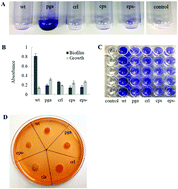Viscoelastic response of Escherichia coli biofilms to genetically altered expression of extracellular matrix components
Abstract
How the viscoelastic properties of the extracellular matrix affect the various biological functions conferred by biofilms is an important question in microbiology. In this study, the viscoelastic response of Escherichia coli biofilms to the genetically altered expression of extracellular matrix components was studied. Biofilms of the wild type E. coli MG1655 and its mutant strains producing different amounts of extracellular matrix components (curli, colanic acid, and poly-β-1,6-N-acetyl-D-glucosamine) were used to examine the viscoelastic behavior of biofilms grown at the solid–atmosphere interface. The results suggest that the presence of curli proteins dominates biofilm mechanical behavior. The rheological data indicate that the cohesive energy of the biofilm was the highest in the wild type strain. The results demonstrate the importance of extracellular matrix composition for biofilm mechanical properties. We propose that by genetically altering the expression of extracellular matrix polymers, bacteria are able to modulate the mechanical properties of their local environment in accordance with bulk environmental conditions.



 Please wait while we load your content...
Please wait while we load your content...